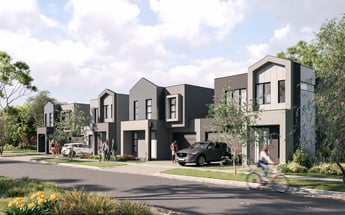Written by

Investing in house and land packages is becoming a popular option for homebuyers across Melbourne's North and West. These packages offer an affordable way to own property in communities that promise an exceptional lifestyle. Beyond homebuyers, this option also presents significant opportunities for investors. If you're seeking to build wealth through property, the ideal investment is one that maximises capital growth and rental yield while minimising upfront costs—and a well-chosen house and land package can be a pathway to achieving that goal.
There are multiple advantages for investors when opting for a house and land package. These include lower maintenance costs, strong rental demand, and potential tax benefits through depreciation. As with any investment, it’s essential to evaluate whether it aligns with your strategy, budget, and the location you're considering.
To help you decide if a house and land package is right for you, let’s dive into some of the key benefits and drawbacks compared to established homes.
Benefits of Investing in a House and Land Package:
Affordability
House and land packages tend to be more affordable, often with a set price. This fixed cost can be appealing, particularly for first-time investors who want to know exactly what they're paying for.
Stamp Duty Savings
One of the major cost savings is stamp duty. When buying a house and land package, you typically only pay stamp duty on the land value, not the home, resulting in significant savings.
Tax Advantages
There are tax benefits associated with new builds, including claiming depreciation on both the building and fixtures. It’s essential to seek advice from a financial expert to fully understand the deductions available to you.
Prime Location
Most house and land packages are located in modern residential estates, often near amenities like schools, parks, and shopping centres. If you choose an area with strong growth potential, this can significantly enhance the long-term value of your investment.
High Tenant Demand
New homes, with contemporary designs and finishes, are attractive to tenants. This can translate into consistent rental income and lower vacancy rates.
Ready-to-Rent Properties
Your new home will meet all the latest building codes and rental standards, allowing you to rent it out without delay.
Low Maintenance Costs
With warranties covering structural aspects and fittings, new homes generally have lower maintenance costs than older properties. You’ll also avoid major repairs that come with aging properties.
Potential for Equity Growth
In some cases, the value of your property may increase during the construction phase, which can quickly build equity and enhance your financial position.
Drawbacks of House and Land Investments:
While house and land packages offer numerous benefits, they come with some challenges as well.
Additional Costs
While the base price may seem attractive, there are other expenses to consider, such as landscaping, fencing, driveways, and window treatments. It’s essential to budget for these to avoid surprises.
More Design Choices
Building a new home requires making many decisions upfront, including floorplans, finishes, and colours. While these choices can be rewarding, they require careful thought to ensure the home’s long-term appeal for renters or buyers.
Limited Suburb Selection
If you're focused on a particular suburb, your options may be more limited with house and land packages. Established homes usually offer a broader range of neighbourhood choices.
Progress Payments
Financing for house and land packages involves making progress payments throughout the construction process. This can be more complex than financing an established home, so it’s wise to work with a mortgage broker to understand the payment structure.
Established Homes: A Comparison
If you're weighing your options between house and land packages and established homes, here are some pros and cons.
Pros of Investing in Established Homes:
Immediate Availability
Since the home is already built, you can inspect it and assess its condition before purchasing.
Location Flexibility
With established homes, you have a wider choice of neighbourhoods, depending on what’s available in the market.
Lower Additional Costs
Most established homes come with all essentials, like driveways and landscaping, included in the sale.
Cons of Established Homes:
Limited Customisation
You may have to accept design choices made by previous owners, which could limit the home’s appeal to future tenants or buyers.
Higher Maintenance Costs
Older properties often come with hidden maintenance issues, which can lead to expensive repairs.
Fewer Tax Benefits
Established properties typically offer fewer tax deductions compared to new builds. Consult a financial advisor to clarify what you can claim.







